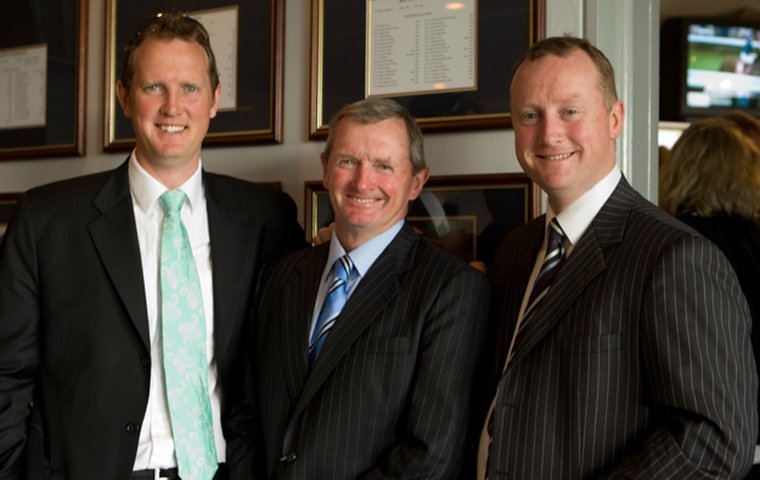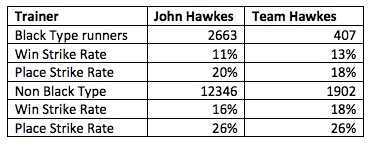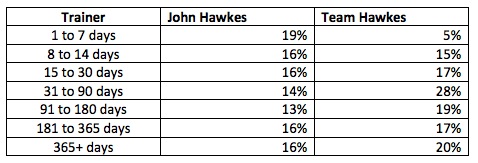
Thoroughbred horse training partnerships are becoming prevalent in Australian racing — more particularly those involving families.

Training partnerships were allowed in New Zealand well before Australia, but recently we have seen successful family partnerships involving: Cindy and Colin Alderson; James and Bart Cummings; Lee and Shannon Hope; Barbara and Paul Joseph; Troy and Leon Corstens; Terry and Katrina Sullivan; John, Wayne, and Michael Hawkes (known as Team Hawkes); and more recently, Peter and Paul Snowden.
Of course, both John Hawkes and Peter Snowden served their “apprenticeship” at the helm of the massive Woodlands Stud, and later Darley training empires, before going it alone with their family members.
Clearly all the family partnerships, mentioned above, have enjoyed success to varying degrees.
Given this growing trend, I thought I might examine the transition of John Hawkes, who went from a high pressure job training some of the best horseflesh available — due in no small way to the significant financial backing of the Ingham Brothers —to relying on private clients with limited capital, under the Team Hawkes banner.
During his time at Woodlands, not only was Hawkes required to win group races, but he also had to “build’ stallions for the breeding-part of the empire — much the same as Peter Snowden’s role under the Darley regime.
Before any trends might become meaningful between the two Hawkes eras, we need at least five years of data — and we now have that to examine - John covering the period Aug. 1, 2002 until Nov. 1, 2007, and Team Hawkes Aug. 1, 2008 until Aug. 23, 2014.
If one believes unlimited funds to purchase yearlings is the key to racetrack success — and that is a pretty long bow to draw which will be the subject of another study — then one would expect the quality of horses between the two eras to vary significantly, and therefore have some impact on raw training strike rates.
John Hawkes commenced his role as private trainer for Jack and Bob Ingham in January 1993 and ended his tenure there in November 2007.
During those 14 years at the helm of the Woodlands training empire, John Hawkes was extremely successful, winning more than 100 G1 races and in excess of 500 Stakes races.
There were not many races John Hawkes did not win, with perhaps the exception of the Melbourne Cup, a race he went close to winning with Maluckyday — who finished second to Americain in 2010. Hawkes also trained two superstar stallions, the unforgettable Octagonal — a 10 time G1 winner — and later, of course, his son Lonhro, the winner of 11 G1 races.
A number of outstanding gallopers also passed through his hands such as Maluckyday, Shame, Railings, Accomplice, Commands, Arena, Guineas, Viscount, Niello, and Camarilla, to mentioned a few.
Team Hawkes commenced training in partnership in October 2008 making a dream start with their first runner Real Saga a Stakes winner in the Breeders’ Plate.
Since then, they have continued to build and today boast a formidable stable of leading spring hopes.
So with around six years of data to analyse we should be able to see if Team Hawkes is indeed mirroring the success of the team mentor, John Hawkes.
Admittedly I am using the last six years of the John Hawkes era when he was a the top of his game — after all the stable “heavy lifting” had been done — and comparing it against the first six years of Team Hawkes — when much of the stable growing was done. However it is an interesting exercise all the same.
I must also mention that both of John’s sons Wayne and Michael were involved in the later part of the Woodlands era to varying degrees as stable foremen and the like.
The first thing that captures the eye in comparing the two eras is the number of runners. John prepared almost six times as many runners as Team Hawkes does today.

In those last years of the Woodlands era, John had stables in Sydney, Melbourne and Brisbane and clearly sat atop a massive training operation, with runners in multiple locations most days of the week.
Interestingly however, the strike rates between the two eras are fairly similar, identical for placings, but with a slightly higher win strike rate for Team Hawkes. Over time we can expect the win strike to settle pretty much in line with John’s.
Next, we look at Black Type and non-Black type races, and again, the sheer number of runners John had in black Type races is mind boggling.

Another very interesting pattern emerges with Team Hawkes being slightly in front on winning strike rate for Black Type races, but slightly behind on placings.
The same winning strike rate trend is apparent for non-Black type races, but identical on placings.
Again the Team Hawkes stats seem to be trending towards John’s long term values.
The next area we will examine is age groups.

These stats are quite surprising, as Team Hawkes is producing superior win strike rates across all age categories.
This is a surprising result, as John had the backing of Woodlands Stud, with its younger horses always coming through the stable — plus the Ingham’s sometimes went shopping with long pockets to supplement their home grown stock.
Perhaps Team Hawkes are being more selective identifying their young horses, and it’s now a case of more quality than quantity.
Stable jockey stats are also interesting.
While Team Hawkes does not have a stable jockey as such, James McDonald is their main rider and he strikes at 26 percent from just under 200 rides.
Darren Beadman was John’s stable rider, the pair striking at 24 percent from just under 1,800 rides — some achievement indeed.
The betting market is probably the most accurate guide of performance that there is, so the following table is important in comparing market expectation for each era.

Once again, there is an uncanny similarity between the two eras. Team Hawkes is only slightly superior, but with roughly 25 percent of the total number of runners compared to John. No doubt we could expect these stats to come into closer alignment as the number of Team Hawkes runners build.
Fitness is a crucial factor for any trainer, and the comparison of both eras on this measure reveals some interesting trends.

Team Hawkes is achieving considerably superior results to those of John’s with horses making their race debut or resuming from a spell. But the figures align more closely from second up onwards.
This is not an aberration. While I would expect the values to converge slightly there is still a marked improvement in the training methods employed by Team Hawkes for debutantes and first uppers.
The number of days since last start also sheds some light on these stats, with the 1 to 7 day back up showing a severe aberration.

The 1 to 7 day back up differential shows a remarkable difference — but can be explained away to some degree by the number of runners in this category.
John had 3 percent of his total runners (460) fall within this time period, whereas Team Hawkes had 1.8 percent of their runners (42) in this category.
Quite clearly, Team Hawkes has a policy of avoiding backing horses up within 7 days, and judging by these figures, punters should also avoid them too.
The other anomaly is horses running between 31 days to 180 days.
Both Team Hawkes and John had a similar percentage of their runners in this category, but the strike rate clearly favours Team Hawkes and by a fair margin.
For example John had 3,031 (20 percent) runners in the 31 to 180 day break from racing category, while Team Hawkes had 405 (17.5 percent) runners.
One explanation for this could be a change in training methods and the employment of more modern, effective techniques, when preparing horses’ fresh off a break from racing. Using blinkers for the first time is another area where Team Hawkes is doing better than John, 21 percent compared to 13 percent, but as far as the comparison of other statistics for the two eras — such as distance changes, finish positions, last start, and beaten margin — there is not a lot of variance in the figures.
So what does this brief analysis tell us about the two eras?
The first point that comes to mind is that unlimited purchasing power does not necessarily translate to more winners or better horses or superior strike rates for trainers.
Secondly, it shows that John and his sons have been shrewd purchasers of young horses for their stable — a skill that probably went unused in the Woodlands days, because they had home breeds.
But his eye for a horse was certainly highlighted by John’s purchase of Octagonal.
While John was extremely successful with a large stable and numbers of runners, the analysis shows that a smaller more selective stable can produce superior results.
With a public stable versus a private one, I guess, there is more pressure to move underperforming horses on, replacing them with better performed gallopers. A public stable is more likely to be under more financial pressure to achieve results, e.g. more bottom line driven.
Finally though, while it is clear Wayne and Michael Hawkes have played a major role in the successful performance of Team Hawkes — assisted by evolving ideas and methods — not surprisingly the statistical analysis clearly points to John being a significance influence on the partnership — a case of carefully blending the old and the new.


